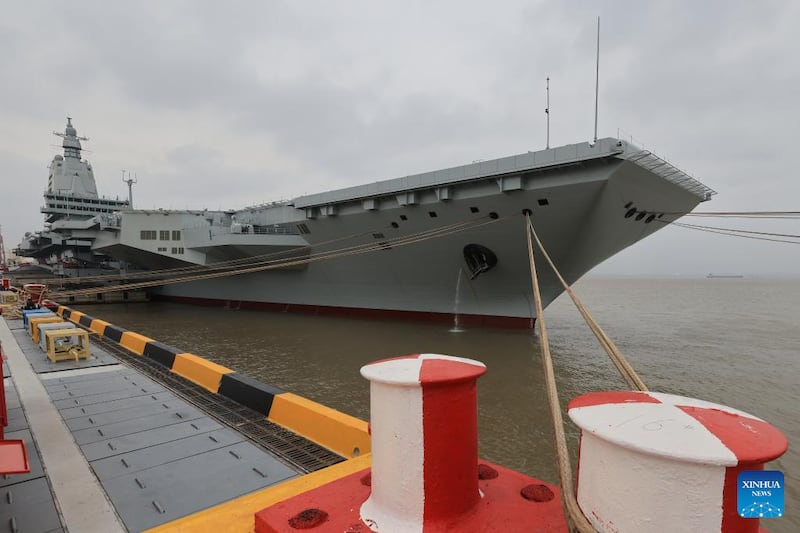Updated May 02, 2024, 03:35 a.m. ET.
China has begun sea trials for its third aircraft carrier, Fujian, a big step towards realizing its naval ambitions amid increased regional tensions, defense analysts said.
Chinese media reported that the 80,000-ton Fujian. a Type 003 class vessel, left Jiangnan Shipyard in Shanghai on Wednesday morning to begin its first trial in the open sea.
The sea trial is primarily aimed at testing the reliability and stability of the aircraft carrier's propulsion and electrical systems, state news agency Xinhua reported.
“This is a huge step forward for the Chinese navy,” said Andreas Rupprecht, a veteran Chinese military watcher.
The sea trial is probably “the most eagerly awaited milestone” for the ship that was launched almost two years ago, Rupprecht told Radio Free Asia.
However, “there is still a lot that we don’t know: if everything works according to plan or whether there remain technical issues,” the analyst said.
Xinhua reported that the Fujian has completed its mooring trials, outfitting work and equipment adjustments and “has met the technical requirements for sea trials” without giving further details.
‘Pride of Chinese Navy’
China’s state CCTV released a clip showing the carrier, flanked by several tugboats, moving out of the shipyard and heading to sea.
This week, the Chinese Maritime Safety Administration issued a navigational warning to ban ships from entering an area in the East China Sea from May 1-9, believed to be the period of the trial.
Sea trials are an important final step towards commissioning the carrier. Some experts believe the carrier could become operational in 2025 while some say they are unsure of the time frame.
Yusuf Unjhawala, a Bangalore-based defense analyst, said that India took a year to carry out sea trials for its indigenous aircraft carrier INS Vikrant.

The Fujian is China’s largest and most advanced carrier, also the first to feature a modern catapult system for launching fighter jets. Experts said the Fujian’s Catapult Assisted Take-Off Barrier Arrested Recovery, or CATOBAR, mechanism is similar to that of U.S. carriers.
China’s first two aircraft carriers – Liaoning and Shandong – use a ski jump-style launch system.
The Fujian is also China’s first carrier built with an indigenous design, unlike the other two which were remodeled from Soviet-made ships.
Combat capabilities
When operational, the Fujian will "significantly enhance the capabilities" of the navy, Chinese experts told the Global Times.
They were quoted as saying it can carry a larger number of aircraft and launch aircraft, including heavier ones, faster and more efficiently than its existing carriers.
Fujian will likely host Shenyang J-15 fighters, as well as the next generation J-35s and the new Xian KJ-600 fixed-wing AEWC (airborne early warning and control) aircraft, according to open intelligence sources.
“The ship’s air complement is based on the Russian Su-33 which it calls the J-15,” said Unjhawala, “It’s a very heavy fighter and it takes off from a ski ramp, which limits its ability to carry arms.”
The aviation component of the new aircraft carrier is beset with technical problems, the analyst said, adding that “it will take time for China to become a formidable carrier force.”
Still, it represents a big leap forward and a warning for countries in dispute with China in the East and South China seas.
Japan has recently decided to upgrade one of its two helicopter carriers to its first aircraft carrier – a decision that was quickly condemned by Beijing.
Aircraft carriers represent China's maritime ambitions and the carrier fleet may be expanded to five ships in the next 10 years, according to a report by the Center for Strategic and Budgetary Assessments (CSBA), an independent U.S. think tank specializing in defense policy, planning and budgets.
China already has the largest navy in the world by number with an overall battle force of more than 370 ships and submarines, compared with the U.S.'s 293, according to the Pentagon. The U.S. Navy, however, has 11 aircraft carriers, most of which are much more advanced and powerful than China's.
The Fujian has a dead weight tonnage of 80,000 tons, similar to one of the U.S.’s ten Nimitz-class ships but significantly smaller than the U.S.’s new Gerald R. Ford carrier of 100,000 tons.
Edited by Mike Firn.
Updated to correct probable date of sea trial.
